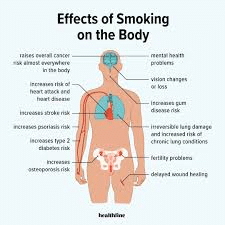
World No Tobacco Day, observed on May 31st, serves as a reminder of the health risks associated with tobacco use and the steps we can take to combat its prevalence. Tobacco, in all its forms, poses significant threats to human health, leading to a myriad of diseases and conditions. This article explores the risk factors of tobacco use, its harmful components, the dangers it poses to health, and effective strategies to curb addiction through medical and therapeutic interventions.
Understanding the Components of Tobacco
Tobacco contains a variety of harmful chemicals, with nicotine being the primary addictive substance. Nicotine stimulates the release of dopamine, creating a temporary feeling of pleasure. However, tobacco smoke contains over 7,000 chemicals, many of which are toxic and carcinogenic. Some of the most dangerous substances include:
- Tar: A residue containing many cancer-causing chemicals.
- Carbon Monoxide: A poisonous gas that reduces oxygen transport in the blood.
- Formaldehyde: A chemical used in embalming that can cause cancer.
- Ammonia: Often used in cleaning products, which can enhance nicotine absorption.

Health Risks of Tobacco Use
The use of tobacco, whether through smoking, chewing, or other means, can lead to numerous health problems. The most significant risks include:
- Cancer: Tobacco use is a leading cause of various aqqcancers, including lung, mouth, throat, esophagus, and bladder cancer.
- Cardiovascular Diseases: Smoking damages the heart and blood vessels, increasing the risk of heart attack, stroke, and hypertension.
- Respiratory Issues: Chronic obstructive pulmonary disease (COPD), emphysema, and chronic bronchitis are common among smokers.
- Pregnancy Complications: Smoking during pregnancy can lead to miscarriage, premature birth, low birth weight, and developmental problems in infants.
- Oral Health Problems: Tobacco can cause gum disease, tooth loss, and oral cancers.

Risk Factors for Tobacco Use
Certain factors can increase the likelihood of tobacco use, including:
- Genetics: A family history of tobacco use can predispose individuals to nicotine addiction.
- Social Environment: Peer pressure, social acceptance of smoking, and advertising can encourage tobacco use.
- Psychological Factors: Stress, anxiety, and depression often lead individuals to use tobacco as a coping mechanism.
- Availability and Accessibility: Easy access to tobacco products increases usage rates, especially among youth.
Strategies to Curb Tobacco Addiction
Overcoming tobacco addiction is challenging but achievable with the right strategies and support systems. Here are some effective methods:
- Behavioral Therapy: Cognitive-behavioral therapy (CBT) helps individuals identify and change smoking-related behaviors and thought patterns.
- Nicotine Replacement Therapy (NRT): Products like nicotine patches, gum, and lozenges can reduce withdrawal symptoms by providing low levels of nicotine without harmful chemicals found in tobacco smoke.
- Prescription Medications: Medications such as varenicline (Chantix) and bupropion (Zyban) can help reduce cravings and withdrawal symptoms.
- Support Groups: Joining support groups or cessation programs provides social support and encouragement from others who are also trying to quit.
- Mobile Apps and Hotlines: Various digital tools and quitlines offer resources, tracking, and motivational support to help individuals stay on track.
Medical and Therapeutic Interventions
Healthcare providers play a critical role in helping patients quit tobacco. They can offer:
- Personalized Quit Plans: Tailored strategies based on individual needs, including setting a quit date and identifying triggers.
- Regular Follow-ups: Continuous monitoring and encouragement to address challenges and celebrate successes.
- Holistic Approaches: Incorporating exercise, stress management techniques, and dietary adjustments to support overall well-being.
The dangers of tobacco use are well-documented, but with concerted effort and support, individuals can overcome addiction and reclaim their health. World No Tobacco Day is an opportunity to raise awareness and encourage those struggling with tobacco dependence to seek help. By understanding the risks and utilizing available resources, we can work towards a future free from the harms of tobacco.

World No Tobacco Day reminds us of the importance of taking steps to reduce tobacco use and its associated health risks. By staying informed and supporting those in need, we can make a significant impact on public health.




